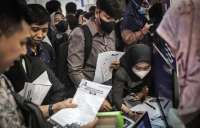Sumber: The Fed | Editor: Hasbi Maulana
MARTY CRUTSINGER. Marty Crutsinger with the Associated Press. You talked about the fact that the Summary of Economic Projections is based on the outlook of all the members of the FOMC. Can you tell us anything, though, about the staff forecast and how that was impacted by the, we had a one and a half trillion dollar tax cut? We've had $300 billion in increased government spending. The staff forecast that you're working with, are those reflected, how were they impacted by that? And, how did that impact the discussions?
CHAIRIMAN POWELL. We look at the staff forecasts and the Board forecasts, and by the way, they're 12 excellent Reserve Bank staffs who have their own views and do their own work. We look at those as informing the decisions of the policy makers. So, and it's really the policy makers' views that we talk about in the SEP. We don't, we don't, you know, talk about the staff forecast. It's a particular thing under, done under particular rules and circumstances, and really, it's the policy makers that, then, take that as input and create their forecasts which are what drives policy.
MARTY CRUTSINGER. That had no impact, though? Such a, that's a major increase in government stimulus that you're, that had to had an impact on the discussions, I would think, though.
CHAIRMAN POWELL. Well, the, you're right. So, fiscal stimulus is a, you know, a meaningful input into, you know, into the SEP and particularly in the changes over the course of last year and this year. And, individual policy makers went through with their staffs, a range of estimates, a range of literature, and did their own thinking and came up with their own estimates and submitted those as their Summary of Economic Projections, as their projections. Those are not the staff's projections. Those are our projections.
HEATHER LONG. Heather Long, Washington Post. I, what would it take to get to four rate hikes this year? It's clear from the dot plot that many members do think four would be appropriate, but clearly something was holding a number of the FOMC members back. Is it concerns about these potential trade tariffs that are going into effect? Is it just that people want to wait and see a little longer before they raise? Can you give us some more insight into why people didn't go to four this time, the media, and even though the economic projections look very healthy?
CHAIRMAN POWELL. I would go back to the thought that, you know, we made one decision at this meeting. And, that decision was to raise the federal funds rate by 25 basis points. The projections are really just individual projections that are submitted and then compiled. And, you know, you're mentioning the median as being, you know, three and four being close. But, you know, I think, like any set of forecasts, those forecasts will change over time, and they'll change depending on the way the outlook of the economy changes. So, that's really all I can say. It could change up. It could change down. I wouldn't want to, for now, these are the best forecasts that people could make. And, you know, it could be that if the economy's a little bit stronger or a little bit weaker, then the path could be a little less gradual or a little more gradual.
HEATHER LONG. So, it wasn't one factor that was pulling at the heart of it.
CHAIRMAN POWELL. Not, no.


/2018/03/08/443373005.jpg)
















